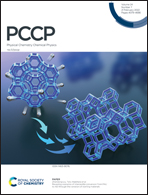Turning the structure of the Aβ42 peptide by different functionalized carbon nanotubes: a molecular dynamics simulation study†
Abstract
Functionalized carbon nanotubes (CNTs) can inhibit the self-assembly of amyloid-beta (Aβ) peptides. Under abnormal conditions, the structure of the Aβ peptides undergoes a fundamental transformation, and this transformation will induce conformational conversions of other polymerized Aβ peptides. Here, we explore the interactions between different functionalized CNTs and Aβ42 peptides by molecular dynamics simulations. Our results show that compared to the original CNTs, the highly functionalized CNTs induce different adsorption patterns of the peptides. This adsorption pattern destroys the α-helix structure and increases the β-turn and random coil content significantly. The hydrogen bonds formed by the peptide and water molecules or CNTs further reveal the reasons for the structural transformation of the peptide. Due to electrostatic interactions and π–π stacking interactions, some amino acids (such as Phe4, Lys16, Phe20, and Lys28) are tightly fixed on the surfaces, and other amino acids move around these amino acids to accelerate the unfolding and denaturation of the peptide. Our research shows that functionalized CNTs have excellent potential to inhibit the abnormal aggregation of Aβ42 peptides. Our research also provides theoretical guidance in the design and synthesis of carbon nanomedicines for protein conformation diseases.



 Please wait while we load your content...
Please wait while we load your content...